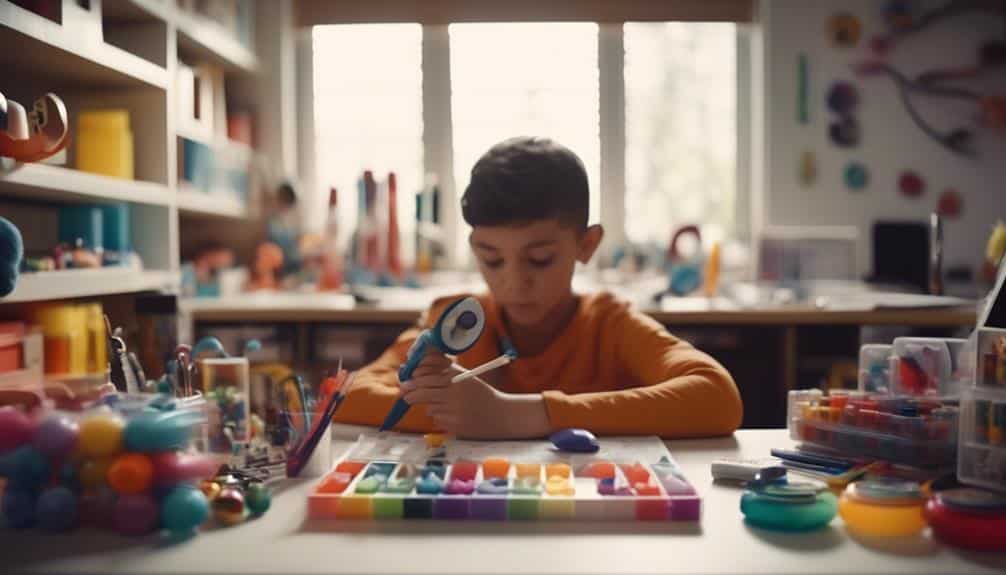In the dynamic field of occupational therapy, the management of ADHD presents a unique set of challenges and opportunities for practitioners. The adoption of behavioral techniques tailored specifically to address the symptoms of ADHD can significantly enhance the efficacy of therapy, providing individuals with the tools they need to navigate their daily lives more effectively. From time management and organization strategies to sensory integration and social skills training, these techniques foster greater independence and confidence in individuals with ADHD. However, the application and success of these methods are contingent upon a nuanced understanding of their principles and the adaptability of therapy to meet each client’s specific needs.
As we explore the six best ADHD behavioral techniques in occupational therapy, it becomes evident that the intersection of theory and practice is vital to unlocking potential and facilitating meaningful progress. Join us as we examine the critical role these techniques play in occupational therapy and how they contribute to the overarching goals of treatment.
Key Takeaways
- Behavior therapy techniques in occupational therapy for ADHD focus on enhancing positive behaviors, reducing disruptive behaviors, and fostering independence and improved social skills.
- Sensory integration strategies and mindfulness exercises in ADHD occupational therapy help customize sensory environments, meet unique sensory needs, enhance attention and focus, and improve overall mental health.
- Preparatory methods and purposeful activities in occupational therapy for ADHD aim to enhance skills and readiness for specific tasks, foster independence and self-efficacy, address practical and social challenges, and promote independence and self-regulation.
- Adaptive equipment utilization in occupational therapy for ADHD assists with organization, time management, sensory regulation, and task completion, tailoring to individual needs and enhancing engagement in daily activities and routines.
Preparatory Methods
Preparatory methods in occupational therapy for individuals with ADHD are designed to enhance their skills and readiness for specific tasks by engaging in activities that align with their interests and goals. These methods serve as a cornerstone in occupational therapy interventions, particularly for children with ADHD, by fostering a sense of independence and self-efficacy.
Through tailored activities such as communication exercises, sports, volunteer work, gardening, and social engagements, preparatory methods aim to improve an individual’s ability to navigate and thrive in social and academic environments.
The essence of these methods lies in their ability to adapt to the environment to meet each person’s unique needs, employing everyday activities therapeutically. This approach supports the development of practical skills and addresses the emotional and social challenges frequently encountered by those with ADHD.
Purposeful Activities
Purposeful activities in pediatric occupational therapy ADHD Behavioral techniques are meticulously designed to enhance attention and focus for individuals with ADHD, fostering meaningful skill development and self-efficacy through engaging in personalized tasks. These activities are not merely tasks but carefully chosen to resonate with the individual’s interests and needs, making each session therapeutic, enjoyable, and meaningful.
By focusing on purposeful activities, occupational therapists can promote independence and self-regulation, crucial skills for individuals with ADHD navigating daily life.
- Tailored to Individual Interests: Activities are selected based on the child’s interests, ensuring higher engagement and motivation.
- Goal-Oriented and Meaningful: Each activity has clear, achievable goals that contribute to developing essential life skills.
- Promotes Independence: Children learn to initiate and complete tasks independently through consistent practice, enhancing their self-efficacy.
Incorporating purposeful activities in occupational therapy for children with attention deficit hyperactivity disorder is a strategic approach that supports the development of academic, social, and daily living skills. It’s a testament to the power of personalized, engaging tasks in fostering attention, focus, and a sense of achievement among individuals with ADHD.
Pediatric Occupation-Based Interventions

Pediatric occupation-based interventions are a cornerstone of occupational therapy for individuals with ADHD, emphasizing the therapeutic use of everyday activities in ADHD Behavioral Techniques. By incorporating task modification techniques, utilizing adaptive equipment, and prioritizing meaningful activities, these interventions aim to bolster self-esteem, enhance performance in various settings, and improve time management skills.
This approach supports the individual and provides essential guidance for family members or caregivers, creating a comprehensive support system.
Task Modification Techniques
Implementing task modification techniques can significantly enhance task completion and overall satisfaction for individuals with ADHD, making these strategies a cornerstone of effective occupational therapy interventions. These techniques, pivotal in treating ADHD, focus on adapting tasks to align with the individual’s unique needs and strengths, thus facilitating better engagement and success.
- Break tasks into smaller, manageable pieces to improve completion and enhance time management skills.
- Visual cues and graphics aid in task completion and increase motivation, providing clear and accessible information.
- Tailor rewards are based on individual motivations to encourage incremental progress, promoting a positive reinforcement loop.
Occupational therapy professionals employ these task modification techniques to support individuals with an ADHD diagnosis in achieving their full potential, demonstrating a commitment to empathetic and practical care.
Adaptive Equipment Utilization
Adaptive equipment, tailored specifically for individuals with ADHD, is crucial in enhancing their ability to engage effectively in daily activities and routines. Occupational therapists work diligently to evaluate the unique environments of their clients—be it at home, work, or school—to identify the specific needs for adaptive tools. These tools are designed to assist with organization, time management, sensory regulation, and task completion, pivotal areas where individuals with ADHD may struggle.
Prioritizing Meaningful Activities
Focusing on meaningful activities, occupational therapists guide individuals with ADHD to engage in tasks that resonate with their interests and aspirations, fostering improved motivation and attention. This approach is a cornerstone of effective treatment, emphasizing the importance of aligning activities with each individual’s needs and goals. By doing so, occupational therapy becomes a tailored and impactful intervention for individuals with ADHD, especially when prioritizing activities that help bridge the gap between capability and performance.
- It identifies activities that provide a sense of accomplishment, boosting self-esteem and self-efficacy.
- It aids in time management by focusing on personally significant and engaging tasks.
- It enhances social participation and overall quality of life through activities that reflect personal interests and goals.
Behavior Therapy Techniques

Behavior therapy techniques offer a comprehensive approach to enhancing positive behaviors and reducing disruptive ones in individuals with ADHD. These techniques employ reward systems, task simplification, structured environments, and mindfulness practices.
In the realm of occupational therapy, these methods are pivotal in addressing the unique needs of those with ADHD. Occupational therapists focus on practical, everyday interventions that foster independence and improve social skills.
Utilizing reward systems and positive reinforcement, occupational therapists can encourage individuals with ADHD to adopt desirable behaviors and enhance self-regulation. This positive feedback loop motivates and empowers them, reinforcing their ability to manage their symptoms effectively.
Moreover, teaching concrete methods for breaking tasks into smaller, manageable pieces can significantly improve task completion and motivation. This makes everyday activities less daunting and more achievable for individuals with ADHD.
Creating a structured environment is another cornerstone of behavior therapy techniques in occupational therapy for ADHD. By minimizing distractions and employing visual supports, therapists can help individuals focus better and stay on task.
Additionally, incorporating mindfulness techniques and self-regulation tools can equip those with ADHD with the skills to manage their symptoms more independently. This increases their self-control and ability to navigate social interactions more smoothly.
Through these behavior therapy techniques, occupational therapy offers a life-changing support system for individuals with ADHD.
Sensory Integration Strategies
As we transition from behavior therapy techniques to sensory integration strategies within ADHD occupational therapy, it’s critical to emphasize the importance of customizing sensory environments and implementing sensory diets.
These approaches are designed to meet the unique sensory needs of each individual, fostering an optimal setting for attention, focus, and overall well-being.
Tailoring Sensory Environments
Creating a tailored sensory environment and utilizing sensory integration strategies is critical to addressing the unique sensory needs of individuals with ADHD. Occupational therapy helps to identify and implement strategies that accommodate a child’s sensory processing disorder, enhancing their ability to engage and learn effectively.
- Develop a Sensory Diet: Customized activities that fulfill the specific sensory needs of the individual.
- Incorporate Heavy Work Activities: Beneficial for most individuals with sensory needs, promoting focus and calmness.
- Explore Alternative Seating Options: Supports better attention and sensory equilibrium in various settings.
Implementing Sensory Diets
Implementing sensory diets tailored to meet the unique sensory needs of individuals with ADHD is a crucial strategy in occupational therapy for enhancing focus and self-regulation. Occupational therapists use sensory diets to provide personalized activities that improve attention, minimize distractions, and reduce impulsive behaviors.
| Approach | Benefit |
|---|---|
| Heavy Work | Enhances focus by providing deep-pressure |
| Alternative Seating | Promotes attention through movement |
| Tailored Activities | Addresses specific sensory needs |
| Sensory Equilibrium | Reduces distractions, improves self-regulation |
These interventions, grounded in both empathy and practicality, align with the consensus statement on ADHD: addressing sensory needs is fundamental. By implementing sensory diets, therapists enable individuals with ADHD to manage sensory input better, fostering an environment conducive to growth and learning.
Mindfulness Exercises

Mindfulness exercises offer a powerful tool for individuals with ADHD, enhancing their ability to focus, regulate emotions, and manage stress effectively. In occupational therapy, integrating mindfulness techniques is a complementary approach to traditional medicine and medication, aiming to improve overall mental health. These practices empower individuals with ADHD to take active control over their impulsive behaviors and attention challenges, fostering a sense of self-awareness and calm.
To engage your audience, consider highlighting the following aspects of mindfulness exercises:
- Deliberate Attention Practices: Encouraging individuals to focus on their present surroundings, helping to anchor their thoughts and reduce distractions.
- Calming Techniques: Using sensory experiences, such as calming scents or sounds, alleviates anxiety and promotes relaxation.
- Routine Grounding Exercises: Teaching strategies to stay present and focused can be particularly beneficial for children with ADHD in managing daily stress and enhancing concentration.
Frequently Asked Questions
What Type of Behavior Therapy Is the Most Effective for ADHD?
The most effective behavior therapy for ADHD is individualized, incorporating structured behavioral interventions, positive reinforcement, and strategies for organization and time management tailored to meet the unique needs and goals of the individual.
How Can an OT Help Someone With ADHD?
An occupational therapist (OT) can significantly aid individuals with ADHD by tailoring environments to their needs, enhancing self-esteem through daily activities, educating families, and fostering improved time management, school performance, and work ethic.
What Are Some ADHD Behavioral Techniques Forr ADHD?
Behavioral interventions for ADHD include positive reinforcement, structured routines, and clear consequences for behavior. These strategies aim to improve attention, decrease impulsivity, and foster positive social interactions, supporting individuals in managing their symptoms effectively.
What Are the Goals of OT for Children With ADHD?
The primary goals of occupational therapy for children with ADHD are to enhance their academic and social success, foster motivation, develop problem-solving skills, and teach strategies for practical task completion and emotional self-regulation.
Conclusion
Attention-deficit/hyperactivity disorder (ADHD) is a mental health condition that can affect the daily lives of individuals, especially in executive functioning, impulse control, attention span, and behavioral patterns. There is evidence that behavioral therapy can be a practical treatment approach for ADHD symptoms. The treatment plan can include a variety of behavioral interventions, such as positive reinforcement, art therapy, Mindfulness-based cognitive therapy, Cognitive-behavioral therapy, and Interpersonal therapy. These therapeutic approaches can be delivered in individual or group therapy sessions and help individuals manage and control their behavior patterns.
Occupational therapists can also provide sensory integration, social skills, and organizational skills training to support individuals with ADHD in their daily life performance, including academic performance. This multifaceted approach addresses the core symptoms of ADHD and empowers individuals to navigate their environments more effectively, fostering independence and promoting long-term well-being.
Recent studies have shown that behavioral therapy is an effective treatment for adults with attention deficit, and it can help them manage their symptoms and improve their quality of life. The outcome measures of ongoing studies include continuous outcomes, secondary outcomes, and measures of distress tolerance. The evidence of conflicts and baseline symptoms has been assessed, and the moderate effect size has been identified. Adverse effects and risk of performance bias have also been monitored.
Behavioral therapy, including dialectical behavior therapy and combined treatment, is more effective than the usual treatment or unspecific control conditions. The study authors and the study protocol have identified the types of interventions and the type of control group.
In conclusion, behavioral therapy is an effective form of therapy for ADHD treatment, and mental health professionals can use it as a supportive therapy to improve the quality of life for individuals with ADHD.


Recent Comments